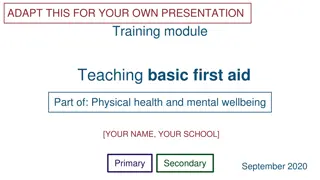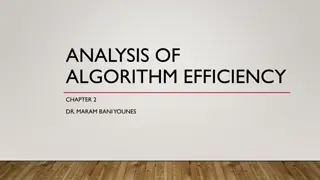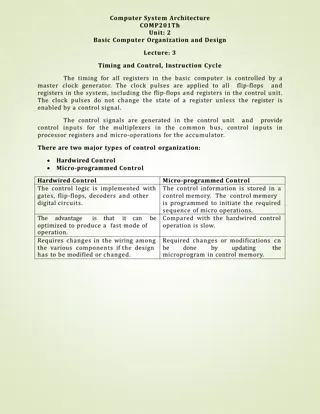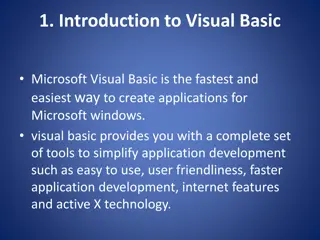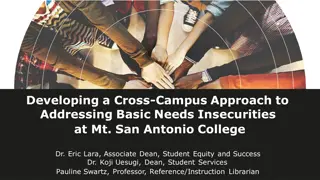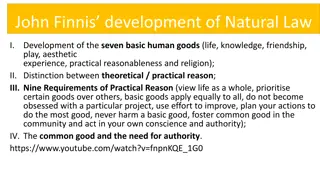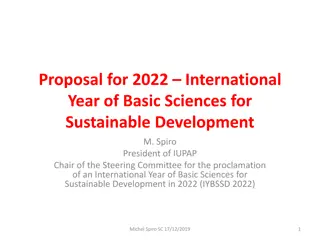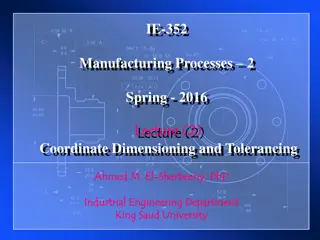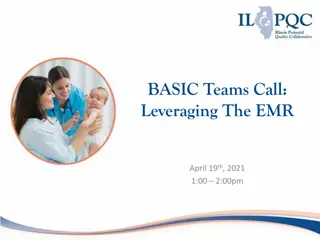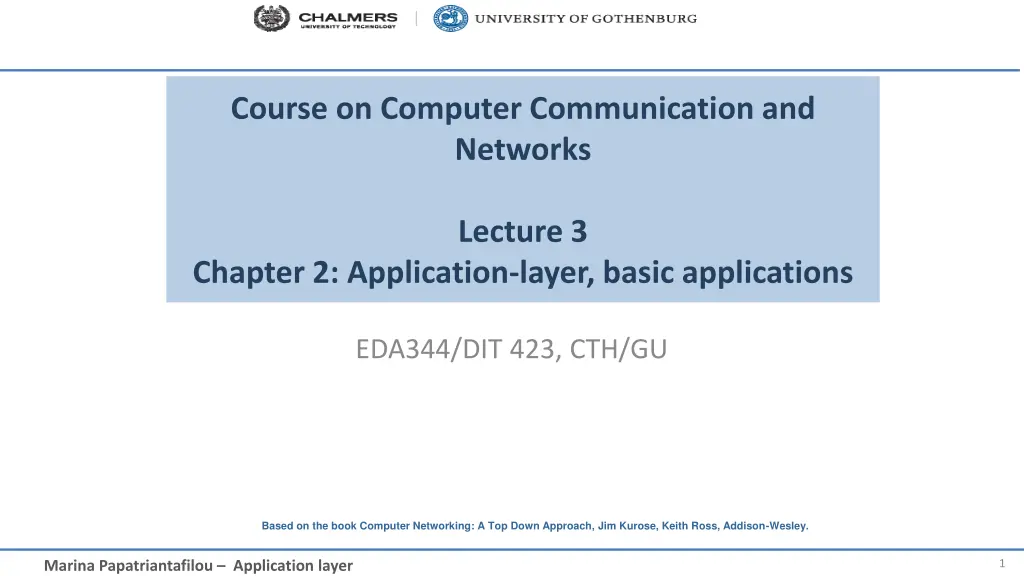
Computer Networking: Application Layer Protocols Overview
Explore the fundamental concepts and implementations of basic application protocols in computer networking. Learn about application-layer protocols, client-server and peer-to-peer architectures, and addressing needs. Delve into topics like HTTP, SMTP, POP, DNS, and more.
Download Presentation

Please find below an Image/Link to download the presentation.
The content on the website is provided AS IS for your information and personal use only. It may not be sold, licensed, or shared on other websites without obtaining consent from the author. If you encounter any issues during the download, it is possible that the publisher has removed the file from their server.
You are allowed to download the files provided on this website for personal or commercial use, subject to the condition that they are used lawfully. All files are the property of their respective owners.
The content on the website is provided AS IS for your information and personal use only. It may not be sold, licensed, or shared on other websites without obtaining consent from the author.
E N D
Presentation Transcript
Course on Computer Communication and Networks Lecture 3 Chapter 2: Application-layer, basic applications EDA344/DIT 423, CTH/GU Based on the book Computer Networking: A Top Down Approach, Jim Kurose, Keith Ross, Addison-Wesley. 1 Marina Papatriantafilou Application layer
Chapter 2: Application Layer Chapter goals: conceptual + implementation aspects of basic application protocols specific protocols: http, smtp, pop, dns, (p2p & streaming, CDN: later in the course) 2 Marina Papatriantafilou Application layer
Applications and application-layer protocols Application: communicating, distributed processes running in network hosts in user space e.g., email, file transfer, the Web Application-layer protocols Are only one piece of an application -others are e.g. user agents. Web: browser E-mail: mail reader streaming audio/video: media player application transport network data link physical application transport network data link physical application transport network data link physical App-layer protocols: define messages exchanged and actions taken use services provided by lower layer protocols 3 Marina Papatriantafilou Application layer
Client-server architecture server: always-on permanent host address clusters of servers for scaling clients: communicate with server may be intermittently connected may have dynamic host addresses client/server 2-4 Marina Papatriantafilou Application layer
Peer2Peer architecture peer-peer no always-on server peers request service from other peers, provide service in return peers are intermittently connected and may change addresses complex management Application Layer 2-5 Marina Papatriantafilou Application layer
Roadmap Addressing and Applications needs from transport layer Http General description and functionality Authentication, cookies and related aspects Caching and proxies SMTP (POP, IMAP) DNS 3a-6 Marina Papatriantafilou Application layer
Addressing, sockets Q: how does a process identify the other process with which it wants to communicate? IP address (unique) of host running other process port number - allows receiving host to determine to which local process the message should be delivered socket: Internet application programming interface 2 processes communicate by sending data into socket, reading data out of socket (like sending out, receiving in via doors) 7 Marina Papatriantafilou Application layer
Roadmap Addressing and Applications needs from transport layer Http General description and functionality Authentication, cookies and related aspects Caching and proxies SMTP (POP, IMAP) DNS 3a-8 Marina Papatriantafilou Application layer
Transport service requirements: common apps application throughput data loss time sensitive file transfer e-mail Web documents real-time audio/video elastic elastic elastic audio: 5kbps-1Mbps video:10kbps-5Mbps few kbps up elastic no loss no loss no loss loss-tolerant no no no y, 100 s msec interactive games text messaging loss-tolerant no loss y, 100 s msec yes and no 9 Marina Papatriantafilou Application layer
Services to upper layer by Internet transport protocols TCP service: connection-oriented reliable transport between sending and receiving process correct, in-order delivery of data setup required between client, server TCP UDP service: connectionless Unreliable, best-effort transport between sending and receiving process UDP does not provide: timing, bandwidth guarantees does not provide: timing, or bandwidth guarantees 10 Marina Papatriantafilou Application layer
Internet apps: application, transport protocols application layer protocol underlying transport protocol application SMTP [RFC 2821] Telnet [RFC 854] HTTP [RFC 2616] FTP [RFC 959] HTTP (e.g., YouTube), RTP [RFC 1889] SIP, RTP, proprietary (e.g., Skype) e-mail TCP TCP TCP TCP TCP or UDP remote terminal access Web file transfer streaming multimedia Internet telephony TCP or UDP 11 Marina Papatriantafilou Application layer
Roadmap Addressing and Applications needs from transport layer Http General description and functionality Authentication, cookies and related aspects Caching and proxies SMTP (POP, IMAP) DNS 3a-12 Marina Papatriantafilou Application layer
Web and HTTP First, some jargon web page consists of objects object can be HTML file, JPEG image, Java applet, audio file, web page consists of base HTML-file which includes several referenced objects each object is addressable by a URL, e.g., www.someschool.edu/someDept/pic.gif path name host name 13 Marina Papatriantafilou Application layer
HTTP: hypertext transfer protocol overview Web s application layer protocol http client: web browser; requests, receives, displays Web objects http server: Web server sends objects PC running Firefox browser uses TCP: 1. client initiates TCP connection to server, port 80 2. server accepts TCP connection 3. HTTP messages (application-layer protocol messages) exchanged 4. TCP connection closed server running Apache Web server iphone running Safari browser 14 Marina Papatriantafilou Application layer
http example (contains text, user enters URL eg www.someSchool.edu/someDepartment/home.index references to 10 jpeg images) 1. http client initiates TCP connection to http server (process) at www.someSchool.edu. Port 80 is default for http server. 2. http server at host www.someSchool.edu waiting for TCP connection at port 80. accepts connection, notifying client 3a. client sends http request message (containing URL) into TCP connection socket 3b. server receives request, forms response message with requested object (someDepartment/home.index), sends message into socket 3c. client receives response msg with file, displays html. Parsing html file, finds 10 referenced jpeg objects 4. server closes TCP connection. time Steps 1-5 repeated for each of 10 jpeg objects 15 Marina Papatriantafilou Application layer
Non-persistent and persistent http Non-persistent (http1.0) server parses request, responds, closes TCP connection non-persistent HTTP response time = 2RTT+ file transmission time new TCP connection for each object => extra overhead per object Persistent on same TCP connection: server parses request, responds, parses new request,.. Client sends requests for all referenced objects as soon as it receives base HTML; Less overhead per object Objects are fetched sequentially (http 1.1) - update http/2: fetches in priority ordering With both, browsers can open parallel sessions 16 Marina Papatriantafilou Application layer
HTTP request message two types of HTTP messages: request, response HTTP request message: ASCII (human-readable format) carriage return character line-feed character request line (GET, POST, HEAD commands) GET /index.html HTTP/1.1\r\n Host: www-net.cs.umass.edu\r\n User-Agent: Firefox/3.6.10\r\n Accept: text/html,application/xhtml+xml\r\n Accept-Language: en-us,en;q=0.5\r\n Accept-Encoding: gzip,deflate\r\n Accept-Charset: ISO-8859-1,utf-8;q=0.7\r\n Keep-Alive: 115\r\n Connection: keep-alive\r\n \r\n header lines carriage return, line feed at start of line indicates end of header lines 17 Marina Papatriantafilou Application layer
HTTP response message status line (protocol status code status phrase) HTTP/1.1 200 OK\r\n Date: Sun, 26 Sep 2016 20:09:20 GMT\r\n Server: Apache/2.0.52 (CentOS)\r\n Last-Modified: Tue, 30 Oct 2007 17:00:02 GMT\r\n ETag: "17dc6-a5c-bf716880"\r\n Accept-Ranges: bytes\r\n Content-Length: 2652\r\n Keep-Alive: timeout=10, max=100\r\n Connection: Keep-Alive\r\n Content-Type: text/html; charset=ISO-8859-1\r\n \r\n header lines data, e.g., requested HTML file data data data data data ... 200 OK: request succeeded, requested object in this msg 301 Moved Permanently: requested object moved, new location specified later in this message (Location:) 400 Bad Request: request message not understood 404 Not Found: requested document not found on this server 505 HTTP Version Not Supported 19 Marina Papatriantafilou Application layer
Trying out HTTP (client side) for yourself 1. Telnet to a Web server: opens TCP connection to port 80 (default HTTP server port) at cis.poly.edu. anything typed in sent to port 80 at cis.poly.edu telnet cis.poly.edu 80 2. type in a GET HTTP request: by typing this in (hit carriage return twice), you send this minimal (but complete) GET request to HTTP server GET /~ross/ HTTP/1.1 Host: cis.poly.edu 3. look at response message sent by HTTP server! 20 Marina Papatriantafilou Application layer
Topic of the programming assignment http server Study http RFCs Work with the implementation (multithreaded server, interaction with client) It is optional, but recommended! You will learn useful stuff 21 Marina Papatriantafilou Application layer
Roadmap Addressing and Applications needs from transport layer Http General description and functionality Authentication, cookies and related aspects Caching and proxies SMTP (POP, IMAP) DNS 3a-22 Marina Papatriantafilou Application layer
HTTP is stateless HTTP server maintains no information about past client requests aside protocols that maintain state are complex! past history (state) must be maintained if server/client crashes, their views of state may be inconsistent, must be reconciled Q: how do web applications keep state though? 23 Marina Papatriantafilou Application layer
Cookies: keeping state client server ebay 8734 usual http request msg Amazon server creates ID 1678 for user cookie file usual http response set-cookie: 1678 backend database create entry ebay 8734 amazon 1678 usual http request msg cookie: 1678 cookie- specific action access usual http response msg one week later: access usual http request msg cookie: 1678 ebay 8734 amazon 1678 cookie- specific action usual http response msg 2-24 Marina Papatriantafilou Application layer
Cookies (continued) aside Cookies and privacy: cookies can bring: authorization shopping carts recommendations user session state cookies permit sites to learn a lot about us we may supply name and e-mail to sites search engines use cookies to learn yet more advertising companies obtain info across sites 25 Marina Papatriantafilou Application layer
Roadmap Addressing and Applications needs from transport layer Http General description and functionality Authentication, cookies and related aspects Caching and proxies SMTP (POP, IMAP) DNS 3a-26 Marina Papatriantafilou Application layer
Web Caches (proxy server) Goal: satisfy client request without involving origin server origin server user configures browser: Web accesses via web cache client sends all http requests to web cache; the cache(proxy) server acts as usual caches do Proxy server client Hierarchical, cooperative caching, ICP: Internet Caching Protocol (RFC2187) client origin server 27 Marina Papatriantafilou Application layer
Why Web Caching? origin servers Assume: cache is close to client (e.g., in same network) smaller response time decrease traffic to distant servers link out of institutional/local ISP network can be bottleneck Important for large data applications (e.g. video, ) public Internet 1.5 Mbps access link institutional network 10 Mbps LAN institutional cache Performance effect: E(delay)=hitRatio*LocalAccessDelay + (1-hitRatio)*RemoteAccessDelay 28 Marina Papatriantafilou Application layer
Roadmap Addressing and Applications needs from transport layer Http General description and functionality Authentication, cookies and related aspects Caching and proxies SMTP (POP, IMAP) DNS 3a-29 Marina Papatriantafilou Application layer
Electronic Mail outgoing message queue user mailbox user agent User Agent a.k.a. mail reader : composing, editing, reading mail messages -e.g., Outlook, gmail mail server user agent Mail Servers Simple Mail Transfer Protocol (SMTP) between mail servers to send email messages client : sending mail server server: receiving mail server SMTP mail server user agent SMTP SMTP user agent mail server user agent user agent 30 Marina Papatriantafilou Application layer
Scenario: Alice sends message to Bob 1) Alice, UA: message to bob@someschool.edu 2) Alice, UA: sends message to her mail server s queue 3) Alice, mail server: TCP connection with Bob s mail server (acting as a client of SMTP) 4) Alice s mail server sends Alice s message over the TCP connection 5) Bob s mail server places the message in Bob s mailbox 6) Bob invokes his UA to read message user agent user agent 1 mail server mail server 3 2 6 4 5 Alice s mail server Bob s mail server 2-31 Marina Papatriantafilou Application layer
Sample SMTP interaction S: 220 hamburger.edu C: HELO crepes.fr S: 250 Hello crepes.fr, pleased to meet you C: MAIL FROM: <alice@crepes.fr> S: 250 alice@crepes.fr... Sender ok C: RCPT TO: <bob@hamburger.edu> S: 250 bob@hamburger.edu ... Recipient ok C: DATA S: 354 Enter mail, end with "." on a line by itself C: Do you like ketchup? C: How about pickles? C: . S: 250 Message accepted for delivery C: QUIT S: 221 hamburger.edu closing connection SMTP (RFC 2821) uses TCP, port 25 three phases handshaking (greeting) transfer of messages closure You can try it out through telnet servername 25 see 220 reply from server enter HELO, MAIL FROM, RCPT TO, DATA, QUIT commands 2-32 Marina Papatriantafilou Application layer
SMTP & Mail message format header RFC 822: standard for text message format: header lines, e.g., To:, From:, Subject: different from SMTP MAIL FROM, RCPT TO: commands Body: the message ASCII 7-bit characters only blank line body Application Layer 2-33 Marina Papatriantafilou Application layer
Mail access protocols mail access protocol (e.g., POP, user agent user agent SMTP SMTP IMAP) sender s mail server receiver s mail server SMTP: delivery/storage to receiver s server mail access protocol: retrieval from server POP: Post Office Protocol [RFC 1939]: authorization, download IMAP: Internet Mail Access Protocol [RFC 1730]: more features, including manipulation of stored msgs on server 2-34 Marina Papatriantafilou Application layer
Roadmap Addressing and Applications needs from transport layer Http General description and functionality Authentication, cookies and related aspects Caching and proxies SMTP (POP, IMAP) DNS 3a-35 Marina Papatriantafilou Application layer
DNS: Domain Name System People: many identifiers: SSN, name, Passport # Internet hosts, routers: IP address (32 bit) - used for addressing datagrams (129.16.237.85) name (alphanumeric addresses) hard to process @ router name , e.g., (www.cse.chalmers.se)- used by humans Q: map between IP addresses and name ? 36 Marina Papatriantafilou Application layer
Hostname to IP address translation Example: www.chalmers.se 129.16.71.10 File with mapping may be edited on the system eg Unix: /etc/hosts - Windows: c:\windows\system32\drivers\etc\hosts Example of an entry manually entered in the file: 129.16.20.245 fibula.ce.chalmers.se fibula Does not scale for all possible hosts, hard to change All hosts need one copy of the file Impossible on the Internet Alternative: DNS, a large distributed database DNS Domain Name System why not centralize DNS? single point of failure traffic volume maintenance 37 Marina Papatriantafilou Application layer
DNS: a distributed, hierarchical database c. Cogent, Herndon, VA (5 other sites) d. U Maryland College Park, MD h. ARL Aberdeen, MD j. Verisign, Dulles VA (69 other sites ) k. RIPE London (17 other sites) i. Netnod, Stockholm (37 other sites) m. WIDE Tokyo (5 other sites) e. NASA Mt View, CA f. Internet Software C. Palo Alto, CA (and 48 other sites) 13 logical root name servers worldwide - each server replicated many times http://www.root-servers.org/ a. Verisign, Los Angeles CA (5 other sites) b. USC-ISI Marina del Rey, CA l. ICANN Los Angeles, CA (41 other sites) g. US DoD Columbus, OH (5 other sites) Root DNS Servers aka Top- Level Domains authoritative DNS servers org DNS servers edu DNS servers com DNS servers poly.edu DNS servers umass.edu DNS servers pbs.org DNS servers yahoo.com DNS servers amazon.com DNS servers 38 Marina Papatriantafilou Application layer
DNS name resolution example root DNS server host at cis.poly.edu wants IP address for gaia.cs.umass.edu 2 3 top-level domain TLD server: responsible for com, org, net, edu, top-level country domains, e.g.: uk, fr, ca, jp dns.poly.edu 4 Local name server acts as proxy for clients, caches entries for TTL Sends queries to DNS hierarchy each ISP has one 5 authoritative DNS server: providing authoritative hostname to IP mappings for organization s named hosts can be maintained by organization or service provider iterated query: contacted server replies with name of server to contact I don t know this name, but ask this server 6 7 1 8 dns.cs.umass.edu requesting host cis.poly.edu gaia.cs.umass.edu 39 Marina Papatriantafilou Application layer
DNS name resolution, another example root DNS server recursive query: puts burden of name resolution on contacted name server heavy load at upper levels of hierarchy? 3 2 7 6 TLD DNS server local DNS server dns.poly.edu 4 5 1 8 authoritative DNS server dns.cs.umass.edu requesting host cis.poly.edu gaia.cs.umass.edu 40 Marina Papatriantafilou Application layer
DNS: distributed db storing resource records (RR) DNS records DNS services hostname to IP address translation host aliasing: canonical, alias names Info for authoritative name DNS server mail server aliasing load distribution replicated Web servers: many IP addresses correspond to one name RR format: (name, value, type, ttl) type=CNAME name is alias name for some canonical (the real) name Eg www.ibm.com is really servereast.backup2.ibm.com value is canonical name type=A name is hostname value is IP address type=NS name is domain (e.g., foo.com) value is hostname of authoritative name server for this domain type=MX value is name of mailserver associated with name 41 Marina Papatriantafilou Application layer
DNS protocol, messages query and reply messages (use UDP), both with same message format identification:16 bit # for query, reply to query uses same # 2 bytes 2 bytes flags: query or reply recursion desired recursion available reply is authoritative identification flags # questions # answer RRs # additional RRs # authority RRs name, type fields for a query questions (variable # of questions) RRs in response to query records for authoritative servers answers (variable # of RRs) authority (variable # of RRs) additional helpful info that may be used additional info (variable # of RRs) 42 Marina Papatriantafilou Application layer
DNS: side note on caching / updating records once (any) name server learns mapping, it caches mapping cache entries timeout after some time (TTL) cached entries may be out-of-date (best effort name-to-address translation!) if name host changes IP address, may not be known Internet-wide until all TTLs expire update/notify mechanisms proposed IETF standard RFC 2136 43 Marina Papatriantafilou Application layer
Inserting records into DNS root DNS server example: new startup Network Utopia register name networkuptopia.com at DNS registrar (e.g., Network Solutions) provide names, IP addresses of authoritative name server registrar inserts two RRs into .com TLD server: (networkutopia.com, dns1.networkutopia.com, NS) (dns1.networkutopia.com, 212.212.212.1, A) Adding a new host/service to domain: Add to authoritative name server type A record for www.networkuptopia.com type MX record for networkutopia.com (mail) .com TLD server: Local DNS authoritative name server dns1.networkutopia.com requesting host Network Utopia host 44 Marina Papatriantafilou Application layer
DNS and security risks DDoS attacks Bombard root servers Mitigation (it actually works ): local DNS servers cache IPs of TLD servers, allowing root server bypass Bombard TLD servers Potentially more dangerous Redirect attacks Man-in-middle Intercept queries DNS poisoning Send bogus replies to DNS server, which it caches Exploit DNS for DDoS Send queries with spoofed source address 45 Marina Papatriantafilou Application layer
Summary Addressing and Applications needs from Transport layer Application architectures client-server (p2p: will study later in the course, after the layers- centered study) specific protocols: Http (connection to programming assignment) Caching etc SMTP (POP, IMAP) DNS Link to representative questions for week 1 Please reply by Saturday 20/1, 7:00 https://goo.gl/forms/7FpM6SJWIRILERee2 Coming soon, after a pass of the 4 top layers - P2P applications - video streaming, content distribution networks and more 46 Marina Papatriantafilou Application layer
Resources Reading list main textbook: Study: 6/e: 2.2, 2.4-2.5, 2.7-2.8, 7/e: 2.2-2.4 Review questions from the book, useful for summary study Chapter 2: 4, 5, 6, 7, 8, 9, 10, 11, 12, 13, 16, 19, 20 Quick reading: 6/e: 2.1, 2.3, 2.6, 7/e: 2.1, 2.5 47 Marina Papatriantafilou Application layer
Extra slides/notes 48 Marina Papatriantafilou Application layer
Example review question Properties of transport service of interest to the app. Bandwidth, Timing, Security Data loss some apps (e.g., audio) can tolerate some loss other apps (e.g., file transfer, telnet) require 100% reliable data transfer In-order vs arbitrary-order delivery some apps (e.g., multimedia, interactive games) require minimum amount of bandwidth, and/or low delay and/or low jitter other apps (elastic apps, e.g. file transfer) are ok with any bandwidth, timing they get Some apps also require confidentiality, integrity (more in network security) 49 Marina Papatriantafilou Application layer
Caching example, as an exercise: assumptions: avg object size: 100K bits avg request rate from browsers to origin servers:15/sec i.e. avg data rate to browsers: 1.50 Mbps RTT from institutional router to any origin server: 2 sec access link rate: 1.54 Mbps consequences: LAN utilization: 1.5% access link utilization = 99% total delay = Internet delay + access delay + LAN delay = 2 sec + minutes + quite_small origin servers public Internet 1.54 Mbps access link problem! institutional network 100Mbps LAN Marina Papatriantafilou Application layer
Caching example: faster access link assumptions: avg object size: 100K bits avg request rate from browsers to origin servers:15/sec i.e. avg data rate to browsers: 1.50 Mbps RTT from institutional router to any origin server: 2 sec access link rate: 1.54 Mbps consequences: LAN utilization: 1.5% access link utilization = 99% total delay = Internet delay + access delay + LAN delay = 2 sec + minutes + usecs origin servers public Internet 1.54 Mbps access link 154 Mbps 154 Mbps institutional network 100Mbps LAN 9.9% msecs Cost: increased access link speed (not cheap!) Application Layer 51 Marina Papatriantafilou Application layer





